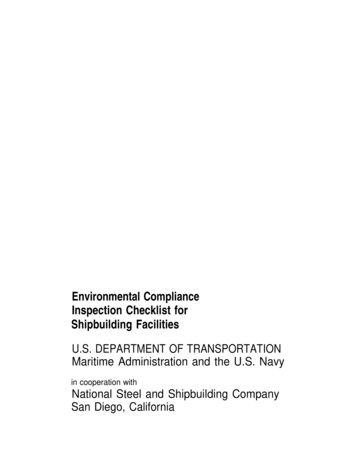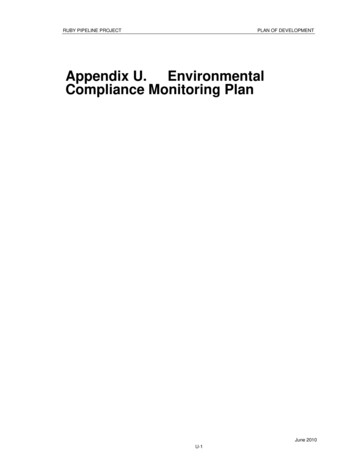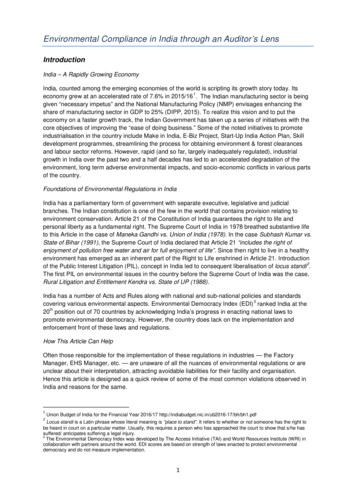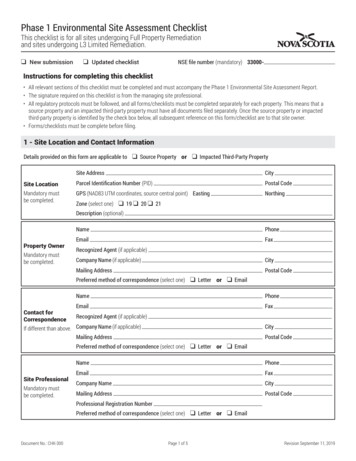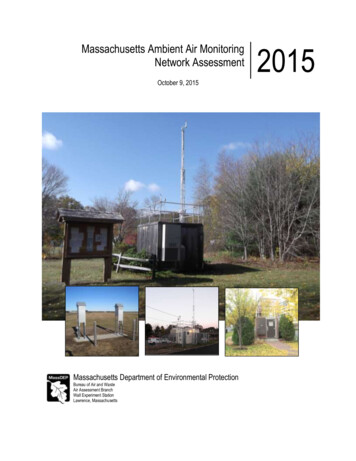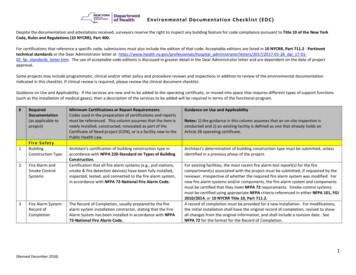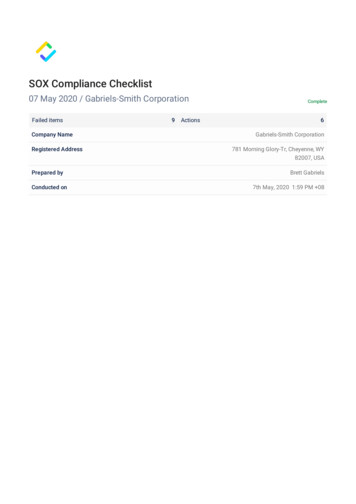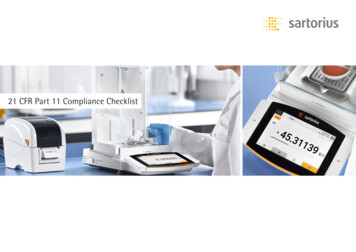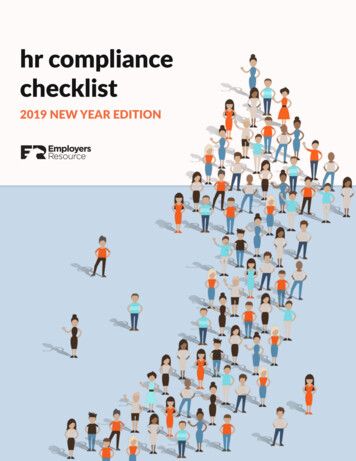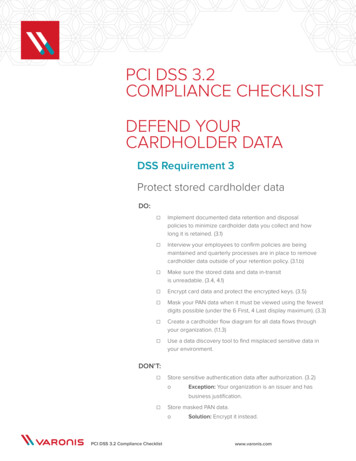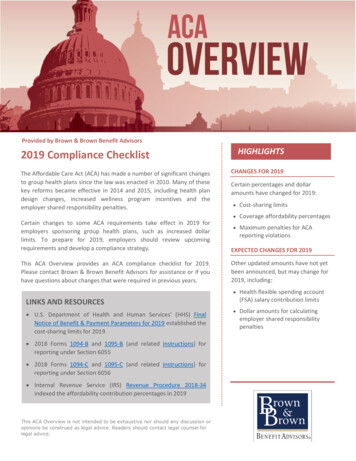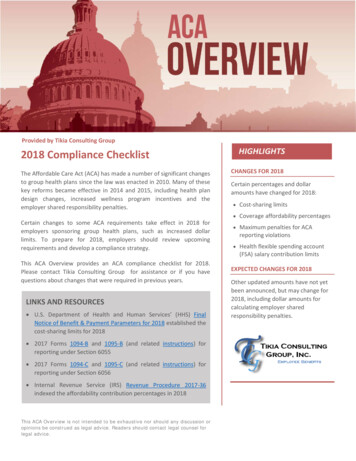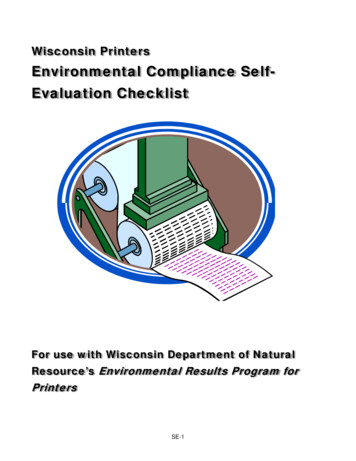
Transcription
Wisconsin PrintersEnvironmental Compliance SelfEvaluation ChecklistFor use with Wisconsin Department of NaturalResource’s Environmental Results Program forPrintersSE-1
This page intentionally left blank.SE-2
Table of ContentsSelf-Evaluation InstructionsEnvironmental Compliance Self-Evaluation ChecklistA. Facility InformationB. Compliance InformationChapter 1 – Air PollutionChapter 2 – Solid and Hazardous WasteChapter 3 – WastewaterChapter 4 – Storm WaterChapter 5 – Spills ResponseChapter 6 – Spills PreventionChapter 7 – Emergency Planning and CommunicationC. Pollution PreventionD. Certification Statement and SignatureSE-3
Self-Evaluation Checklist InstructionsCriteria for Printing Facilities to Utilize the ChecklistThe Printers Environmental Compliance Workbook and this Self-Evaluation Checklist comprise a twopart compliance assistance package provided under the Wisconsin Environmental Results Program(ERP) for Printers. Any printer with printing operation identified under a primary Standard IndustrialClassification (SIC) Code of 23, 26 or 27 or a primary North American Industry Classification System(NAICS) code of 32311x or 5111x for the operations at their business will be subject to therequirements included in the ERP. There are two exceptions: Manufacturers or other businesses where printing is an ancillary operation. Facilities with actual emissions of air pollution greater than any one of the following levels: 25 tons per year of any criteria air pollutant (Volatile Organic Compounds (VOCs), NitrogenOxides, Carbon Monoxide, Sulfur Dioxide, Particulate Matter), or 5 tons per year of any single Hazardous Air Pollutant (HAP), or 12.5 tons per year for any combination of HAPs.If your facility falls into either or both of these categories, the workbook and checklist do not cover allrequirements that may apply to your facility.ParticipationTo determine whether it is appropriate for your facility to utilize the Printer Environmental Complianceworkbook and the Self-Evaluation Checklist, you should review Section A of Chapter 1 – Who is thisworkbook designed to help? Complete the evaluation of your ink and solvent usage or calculate youremissions as indicated to determine if your facility’s air emissions are within the ranges covered by theworkbook. Larger printers with emissions greater than the listed thresholds may have requirementsthat are not addressed within this workbook and are advised against solely using the workbook and thischecklist for determining compliance.What is a Self-Evaluation Checklist?In order to improve environmental protection and generate savings for both government and business,printers can now perform a self-evaluation of their facility’s compliance to determine if they meet allrequirements established by the Wisconsin Department of Natural Resources (DNR).This new, common-sense approach to regulation holds great promise for making it easier for theprinting industry to meet – and surpass – Wisconsin’s environmental regulations. This package,developed in conjunction with a group of industry representatives, contains the materials needed tocomplete the self-evaluation checklist. The accompanying workbook provides the information needed tohelp you understand and comply with state and federal environmental regulations.You no longer need to wait until a DNR inspector shows up at your door to find out if you are incompliance with environmental standards. If you use the compliance assistance materials in thispackage, you will be ready for an inspection. The entire package has two parts:SE-4
1. Environmental Compliance Assistance Workbook: The workbook explains theenvironmental standards that apply to your facility, and how to make sure you are complyingwith these standards. The workbook is designed to be used in conjunction with theaccompanying self-evaluation checklist and can also be used as a reference for day-to-dayoperations. The workbook also provides information regarding best management practices andpollution prevention techniques that can help your facility minimize health risks andenvironmental impacts while saving money. Finally, the workbook explains how to certify yourcompliance with environmental regulations.2. Environmental Compliance Self-Evaluation Checklist: The checklist contains a series ofcompliance questions, which generally require “yes” or “no” answers about whether your facilityis following the applicable environmental requirements. After completing the checklist, you willknow your facility’s compliance status.What will DNR do if I’m NOT in compliance with a requirement?Participants in the Printer ERP program will be covered by the deferred civil enforcement provision inWisconsin’s Green Tier law if they voluntarily submit the Self-Evaluation form and a summary ofcorrective actions for each requirement found not to meet the rules. The checklist may serve as part ofan environmental audit process available to printers. Some printers may discover areas where theirfacility is not in compliance. Actions needed to achieve compliance should be taken as soon aspossible. If a compliance issue is discovered by the DNR before compliance is achieved, the DNR mayneed to take enforcement action.To help printers with noncompliance issues, a program called the Wisconsin Compliance AuditProgram is available. The Audit Program offers limited liability for certain requirements and situations toprinters that complete an environmental audit. Reviewing the workbook and completing the checklist isan option for performing an internal environmental audit. To use the Audit Program, a printer wouldneed to do the following: Notify the DNR of the intent to complete an audit of the environmental requirements, submittedat least 30 days prior to completing the audit. Complete the audit using the Compliance Assistance Workbook and Self-Evaluation Checklist.Summarize areas where the checklist indicates the facility is not in compliance in an auditreport. Report any findings to the DNR within 45 days of completing the audit report, and prepare acompliance plan. Provide a schedule for any requirements that will require time to implement acompliance plan. Follow the compliance plan timelines described in the Audit Program. Formore information, visit: http://dnr.wi.gov/business/audit.html.Do I have to participate in the ERP?Participation in the program is voluntary. Completing the self-evaluation checklist provides acomprehensive evaluation of your facility’s compliance status, making you better prepared for a randominspection. Wisconsin’s audit immunity law can be applied to any facility submitting the self-evaluationform to DNR as indicated above. If you do not wish to participate, consider completing the workbookand checklist for internal use.SE-5
Step-by-Step Instructions for Completing the Self-Evaluation ChecklistA. Facility InformationIn this section, list the name and address of your business and the individual responsible for completingthe self-evaluation.B. Compliance InformationThese questions pertain to background information about your facility and information about whetheryour facility is meeting applicable environmental protection standards and requirements. The workbookcontains the information you will need to answer the questions. The checklist tells you where in theworkbook you can find information about the environmental requirements referred to in each question.Consult the workbook before answering any questions. Most of the questions are “yes” or “no”questions about compliance with particular standards. If you are not in compliance with anyrequirement on the date you complete the checklist, complete a Return-to-Compliance Plan (describedbelow) so you can follow up with corrective action.It is your responsibility to keep your facility in compliance with environmental protection requirements atall times. You may be subject to enforcement action if your facility does not comply with the standards.The checklist includes some questions that ask whether you have been doing a routine activity for thepast year, such as properly maintaining equipment. Be sure to comply with the requirements throughoutthe year.C. Pollution PreventionUsing pollution prevention and waste reduction opportunities can be a means of complying withenvironmental regulations. These practices also increase overall environmental performance and costcompetitiveness. There is no right or wrong answer to the question of how many actions you havetaken in this chapter. The intent is to gauge how many facilities are adopting more pollution preventionactions over time.D. Certification StatementThere are specific positions within a business that are approved as the “responsible corporate official”and have the authority to sign the certification statement. Check the appropriate position as outlined inSection D below.MAKE MULTIPLE COPIES OF THE CHECKLIST QUESTIONS BEFORE YOU BEGIN.SUBMIT A CLEAN FINAL COPY TO:WI DNRSBEAP - OB/7PO Box 7921Madison WI 53707-7921SE-6
Wisconsin Department of Natural ResourcesEnvironmental Results Program For PrintersEnvironmental Compliance Self-EvaluationA. Facility InformationFacility NameFacility SICFacility ID NumberStateZip CodeTitleTelephone NumberFacility Street AddressCityPhone NumberFax NumberContact Person NameContact Email AddressB. Compliance InformationAnswer all questions, unless you are directed to skip a question. Do not answer questions that you aredirected to skip.Part I: Regulatory Programs Under DNRChapter 1—Air PollutionA.1. What is your facility’s VOC Size Category? (Read SectionA, page A-1 to A-2.)A.2. Are you meeting all VOC emission requirements listed inthis section? (Read Section A1, page A-2 to A-4)Very SmallSmallYes. (Very Smalland Small Printersskip to A2 unlessyou have a controldevice.)MediumNo. Contact SBEAP forassistance.A.3. Medium Printers and Small or Very Small using a controldevice: Are you meeting all applicable VOC emissionstandards listed in this section? (Read Section A1, page A4 to A-8)YesNo. Contact SBEAP forassistance.A.4. Can you meet the requirements for fuel burning units?(Read section A2, pages A-8 to A-10)YesNo. Contact SBEAP forassistance.A.5. Do you meet the requirements for PM from heatsetpresses? (Read section A3, pages A-10 to A-11)YesA.6. Have you applied the recommended actions for particulatematter control from paper trim systems? (Read section A3,page A-11 to A-12)A.7. Do you meet the visible emission requirements? (ReadSection A4, page A-12)A.8. Very Small Printers: Are your HAP emissions below all thethresholds for the compounds listed in the table on A-15 toA-16? (Read section B and B1, page A-13 to A-16)SE-7YesNo. ContactSBEAP for assistance.NANo. Recommended.YesNo. Contact SBEAP forassistance.YesNo. Contact SBEAP forassistance.
Wisconsin Department of Natural ResourcesEnvironmental Results Program For PrintersEnvironmental Compliance Self-EvaluationB. Compliance Information (cont.)A.9. Small and Medium Printers: Are your HAP emissions belowthe table thresholds on page A-15 through A-19? (Readsection B2, page A-17 to A-19.)A.10.Are you reporting air emissions via DNR’s CRS? (Readsection C1, page A-19)YesNo. Contact SBEAP forassistance.YesNo. Contact SBEAP forassistance.A.11. Are you maintaining all records required for your sizeprinter? (Read section C2, pages A-19 to A-20)YesNo. Contact SBEAP forassistance.A.12. Have you applied for the appropriate permit or are youexempt? (Read section D, pages A-20 to A-21)Yes.A.13. Have you adopted any of the recommended BMPs?(Read page A-22)YesNo. Recommended.Yes.No. Start a program.No.ContactSBEAPNot applicable.Facility is exempt.Chapter 2—Solid and Hazardous WasteHW.1. Do you have a recycling program that includes items suchas office paper, plastic, e-waste, aluminum, etc.? (It's notnecessary to have all listed to check “Yes.”) (Readsection B1, page HW-2 to HW-3)HW.2. Do you generate any hazardous waste? (Read sectionB2, pages HW-3 to HW-6.)Yes. Continue onwith the workbook.No. Skip to the nextchapter.HW.3. What is your generator status? (Read section C, pageHW-6 to HW-10)VSQGHW.4. Do you meet the requirements that apply to all hazardouswaste generators? (Read section D1, page HW-11)YesNo. Correct immediately.HW.5. Are your containers labeled properly? (Read section D2,pages HW-11 to HW-12)YesNo. Correct immediately.HW.6. Are you meeting all of the waste handling requirementsspecific to your generator status? (Read section D3, pageHW-12 to HW-13)YesNo. Correct immediately.HW.7. Are you following all of the waste storage andaccumulation requirements? (Read section E1, page HW13 to HW-14)YesNo. Correct immediately.Contact SBEAP forassistance.HW.8. Are you meeting the proper hazardous wastetransportation/shipping requirements? (Read section E2,page HW-15 to HW-16)YesNo. Correct immediately.HW.9. Are you meeting the applicable training requirements?(Read section F, page HW-16)YesHW.10. Have you adopted any of the recommended BMPs?(Read page HW-17)YesSE-8SQGLQGNo. Develop a trainingplan and provide training.No. Recommended.
Wisconsin Department of Natural ResourcesEnvironmental Results Program For PrintersEnvironmental Compliance Self-EvaluationB. Compliance Information (cont.)Chapter 3—WastewaterWW.1 Are you on a septic system? (Read page WW-1)No. Skip to questionWW.3.Yes.WW.2. Do you discharge industrial wastewater to a septicsystem? (Read section A1, pages WW-1 to WW-2)Yes. Ceasedischarge.No.WW.3. Do you discharge industrial wastewater to a POTW?(Read section A2, page WW-2)Yes.No. Skip to questionWW.5.WW.4. Are you in compliance with the POTW’s sewer use codeand requirements? (Read section A2 and A3, pages WW2 to WW-3)Yes.No. Work with POTW tomake corrections.WW.5. Do you discharge industrial wastewater to the ground, orsurface water without a permit? (Read section A4 to A6,pages WW-3 to WW-4)Yes. Ceaseunpermitteddischarge and applyfor appropriate permit.No.WW.6. Do you store no
2. Environmental Compliance Self-Evaluation Checklist: The checklist contains a series of compliance questions, which generally require “yes” or “no” answers about whether your facility is following the applicable environmental requirements. After completing the checklist, you will know your facility’s compliance status.
